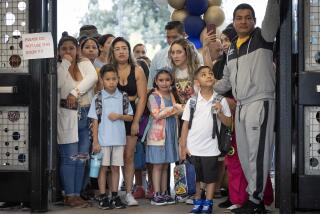Calming Fears of Flying
- Share via
Twelve-year-old Michael Duane was suddenly reluctant to fly to California to visit his grandparents. My 10-year-old daughter, usually a calm flier, was unusually jittery before she boarded her flight to camp in Minnesota. “This plane won’t crash,” Reggie kept repeating.
“It’s everywhere,” said Nancy Schretter, who directs America Online’s Family Travel Network.
In the aftermath of the crash of TWA Flight 800, many people are nervous about flying, and kids can’t help but be affected, especially with so much coverage devoted to the children and teenagers who died on that flight.
“The fact that there were so many kids makes it seem more real to them,” said Sheila Ribordy, a child psychologist at DePaul University in Chicago. Ribordy, whose specialty is childhood fears, said those who are most vulnerable are the grade-school crowd, who worry about their safety anyway.
Coming on the heels of May’s ValuJet crash in Florida and in the middle of the heaviest family travel season of the year, the impact of the crash on childhood fears could be substantial. Not only are thousands of families flying on long-planned trips, but every day hundreds of children are flying unaccompanied to camp, to visit divorced parents or, as was the case on TWA 800, to a summer adventure.
“The fact that it crashed out of the blue makes me worry that it could happen to me,” explained Michael, who lives in New Jersey. “I’m not sure there’s anything I can do to make me less nervous,” he said. Younger kids might not be so articulate, of course. They might react by having nightmares before a scheduled trip or by simply being difficult.
But parents can do a lot to help. Once you’ve decided to fly, deal with your own fears and anxieties. “Kids pick up fears from their parents,” explained Stephen Garber, an Atlanta child psychologist and coauthor of “Monsters Under the Bed and Other Childhood Fears” (Random House, $20). “If you’re a fearful flier, you’ll transfer that to the kids.” Conversely, if you’re optimistic and confident, the kids will be calmer too.
It helps to explain to children that airline accidents, though horrible, are rare events. In a typical three-month period, according to Air Transport Assn. statistics, more people die on the highway than in all of the accidents in the history of U.S. commercial aviation. Over the past 10 years, there was only one fatality for every 3 million people who flew a scheduled U.S. airline flight.
Take the kids to the airport ahead of the flight and let them watch planes take off and land safely. Board early and visit the cockpit, suggests Tom Bunn, a longtime United Airlines pilot and social worker who has developed a fear management and aviation education program called SOAR that has helped ease the fears of 3,000 people afraid to fly. (Call (800) 332-7359 for information.) If the kids are lucky, Bunn says, the captain may demonstrate the lights and sounds that help keep the plane flying smoothly.
Such efforts are more important than you might think. “Kids like to know someone is in charge and will take care of them,” explained DePaul’s Ribordy. If children are flying alone, make sure they’ve met the flight attendants too. “But don’t depend on those on board to occupy them and calm them down,” Bunn said. Children need toys and games to keep them focused on something other than their anxiety. The more time they have on their hands, the experts explain, the more time they’ll have to worry.
Ribordy went a step further. For those youngsters anxious about flying, she suggested some simple relaxation techniques: On a note card, have them make a list of things they like to think about, that are really fun, such as a joke recently played on a big brother or a trip to the local water park. Teach them to look at the card and conjure up those images when they get frightened. (It works for adults too.)
Deep breathing is also helpful. “The children need to feel empowered, that they can do something to help themselves,” Ribordy said. They also need their parents to acknowledge their fears. “Don’t put them down for being afraid,” Garber said. “They need to know you take them seriously.”
Encourage children to talk about why they’re afraid, Garber said, and how, with your help, they can overcome their fears. Don’t make the mistake of thinking they’ll just outgrow it. “The adults we see (with problems) are the ones who hid their fears as kids,” Garber said.
The morning after TWA 800 crashed, Emily Sachar put her daughter on the same flight as mine. “Everything you do involves an element of risk,” she said. “We’re all vulnerable, but we have to move forward and live our lives.”
Taking the Kids appears the first and third week of every month.
More to Read
Sign up for The Wild
We’ll help you find the best places to hike, bike and run, as well as the perfect silent spots for meditation and yoga.
You may occasionally receive promotional content from the Los Angeles Times.






